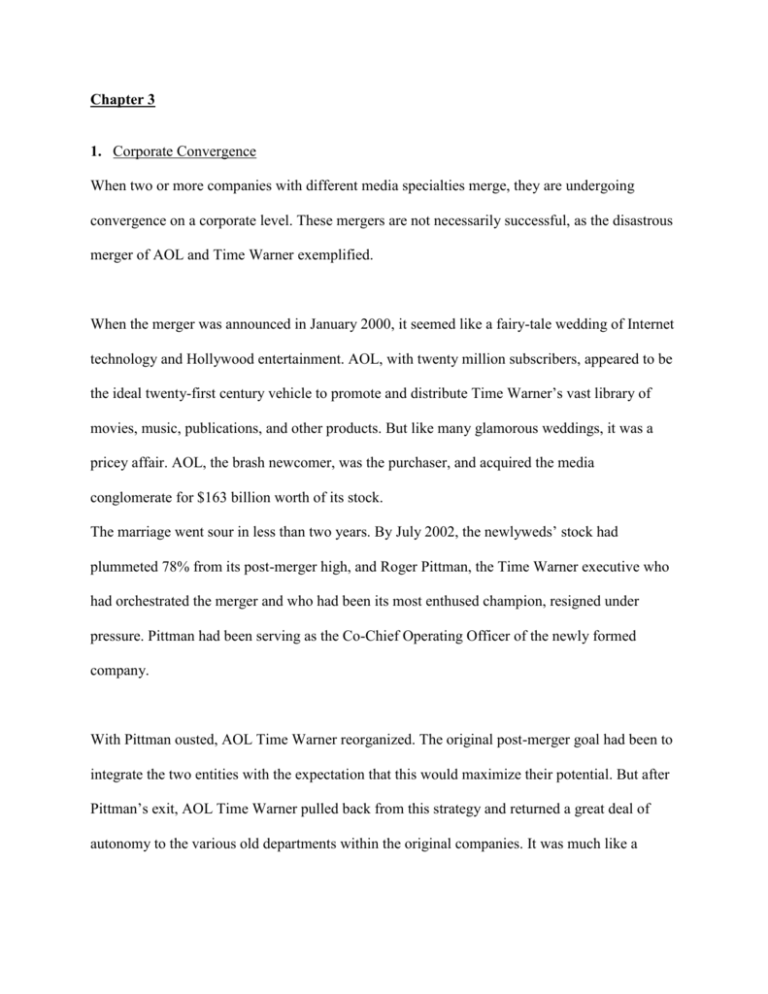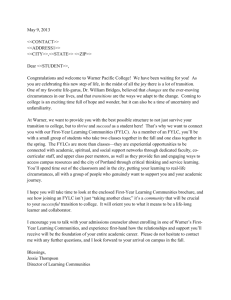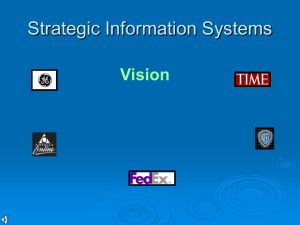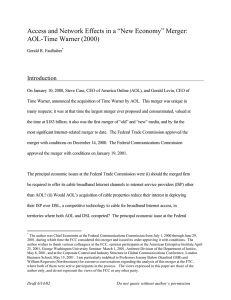Chapter 3 - Amazon Web Services
advertisement

Chapter 3 1. Corporate Convergence When two or more companies with different media specialties merge, they are undergoing convergence on a corporate level. These mergers are not necessarily successful, as the disastrous merger of AOL and Time Warner exemplified. When the merger was announced in January 2000, it seemed like a fairy-tale wedding of Internet technology and Hollywood entertainment. AOL, with twenty million subscribers, appeared to be the ideal twenty-first century vehicle to promote and distribute Time Warner’s vast library of movies, music, publications, and other products. But like many glamorous weddings, it was a pricey affair. AOL, the brash newcomer, was the purchaser, and acquired the media conglomerate for $163 billion worth of its stock. The marriage went sour in less than two years. By July 2002, the newlyweds’ stock had plummeted 78% from its post-merger high, and Roger Pittman, the Time Warner executive who had orchestrated the merger and who had been its most enthused champion, resigned under pressure. Pittman had been serving as the Co-Chief Operating Officer of the newly formed company. With Pittman ousted, AOL Time Warner reorganized. The original post-merger goal had been to integrate the two entities with the expectation that this would maximize their potential. But after Pittman’s exit, AOL Time Warner pulled back from this strategy and returned a great deal of autonomy to the various old departments within the original companies. It was much like a solution reached by an unhappy couple who cannot afford to divorce, but who agree to live in separate wings of the house. In the Los Angeles Times coverage of the AOL Time Warner shake-up (July 19, 2002), staff writers Edmund Sanders and Jan Healey commented that the ambitious merger might have failed because it was too sweeping. “In the rush to maximize synergies,” they wrote, “AOL Time Warner may have made a classic mistake: losing sight of what customers really want.” The article also included a remark by Frank Catalon, head of an Internet marketing firm. “Convergence is a slow process,” they quoted him as saying. “It shouldn’t be a top-down effort. You start by taking small steps.” Interestingly, the failure of this merger to thrive was blamed on the same factors that were cited in the disappointing outcome of the first iTV ventures: that they offered services that customers did not want or were not ready for. 2. Convergence in a Fridge The “smart fridge” admittedly sounds like an idea culled from a science fiction novel but it was a real product, manufactured by LG Electronics. Officially dubbed the “Internet Refrigerator,” this futuristic household appliance was designed to do quite a bit more than chill one’s food. It was also a full service entertainment center, incorporating a TV, a radio, and a built-in digital camera. Furthermore, as its name suggests, it connected to the Internet, and, through its four hi-fi speakers, it could play music that it has downloaded from the Web. On the pragmatic side, it listed all the foods stored within, and could alert the owners to when certain products were running low or are going bad. It could also serve as a message center and date book for the entire family. As if all this were not enough, the titanium surface is smudge proof—something that could be its most winning feature in a household of sticky-fingered kids. This refrigerator was priced at $8500 in 2003, but it did not prove to be a hit with consumers. Less ambitious versions of smart refrigerators have come on the market since then and are still available. Whether or not such refrigerators do well commercially, however, experts in consumer electronics foresee an increasing number of smart appliances coming on the market, and some will certainly incorporate entertainment features. Products such as the smart fridge are part of a development trend termed “the Internet of things.” 3. Convergence of Movies and Toys In Chapter 20, we take a look at smart toys and how some toys have been adapted from popular movies, which is another form of convergence. For example, Playmate Toys adapted the Belle character from Disney’s movie, Beauty and the Beast, and turned her into an interactive doll, part of their My Interactive Princess line. The challenge here was to find a way to have the doll come to life and tell you about her romance with the Beast, but to do so without it being a passive experience, with the doll telling the story and the child just sitting there listening. The solution that Playmate Toys came up with was to give the child an opportunity to participate in Belle’s story via an array of props and “costume changes.” For example, when you remove Belle’s workaday pinafore and dress her up in her magnificent yellow ball gown, she will tell you the part of the story in which she and the Beast spin happily around the dance floor. And by changing the pictures in her magic mirror and putting the mirror in her hand, you can help make Belle’s dreams of love come true, and learn how the Beast is transformed into a handsome prince. Some of the props, when placed in Belle’s hand, even speak in their character voices from the movie. Among them are Mrs. Potts, the chatty, motherly teapot, and Lumiere, the candelabra, who speaks with a French accent. 4. Convergence in Movies and Games Games and movies have been influencing each other for many years now. An early example of this is the British film Sliding Doors, about a young woman (Gwyneth Paltrow) whose life takes two separate paths when in one instance she rushes to catch a subway train and makes it, and in the other instance she just misses the train. From the subway incident on, the movie uses a branching plotline that is a very game-like type of structure. It also depicts two parallel universes that exist simultaneously in time, another game-like convention. In the movie, we get to see Gwyneth Paltrow go down two different story paths, transferring back and forth from one to the other at various game-like “nodes” along the way. However, she does not consciously choose which path to follow the way a player would in a game. Also, in the movie, we get to see how each storyline is resolved, an opportunity we would not have in a game, unless we played it more than once. In a game, of course, the ultimate outcome would be based on the choices we made at each node or decision point. Nevertheless, for a linear piece of work, Sliding Doors does a remarkable job at reflecting a game-like experience. As another example of the influence of games on movies, take the sci-fi film trilogy, The Matrix. Like Sliding Doors, they also present a structure with two parallel universes, but in these movies the characters can jump between worlds in a much more deliberate and conscious fashion than in Sliding Doors. The choreography of its dazzling fight scenes looks remarkably like what one might find in a video game, as does its dark, threatening ambience. These aspects of the movies were successfully transferred to the Matrix video game, Enter the Matrix. 5. Convergent Television Entertainment Why must convergent television applications stop at iTV and video on demand? Why can’t we have other forms of convergent television entertainment? The ever adventurous BBC is broke fresh new ground here by developing an entirely new kind of TV experience called FightBox, first aired in the fall of 2003. FightBox was a TV show that also utilized the Web, game technology, and virtual characters, and was also offered as a stand-alone multiplayer video game. FightBox is a gladiator-style competition featuring virtual characters that have been digitally created by members of the general public. These synthetic warriors battle ferociously with each other and are also pitted against a cast of digital “in-house” characters called FightBox Sentients—monster like beings with awesome powers. The programs are shot live in front of a studio audience, and the human “masters” of the warriors are visible on the set as they control their fighters in the arena. The technology developed for FightBox allows virtual warriors and the show’s human hosts to stand and sit side-by-side and even to chat. Members of the TV audience might even find themselves in the action, with one of the virtual warriors hurled from the arena right into their laps. FightBox, in the spirit of the Web, offered ample opportunities for players to interact with each other online. For example, they could trade with each other for new or used body parts for their warriors, or form online “tribes” to pool information and resources. And, as with almost any other website, they could participate in online forums. Soon after the FightKit tool became available, in May 2003, multiple forums on the website were already fat with thousands of posts, and some forums were even spawning their own Web pages.











